Mechanical Hub continues its conversation regarding heat pumps and heat pump technology. Electrification and carbon reduction is core to the emergence of heat pump technology. We recently spoke with Mark Chaffee, VP Governmental Affairs and Commercial & Industrial Product Management, Taco Comfort Solutions. MH: What are some of the driving forces behind heat pump technology? Chaffee: The Read more
Featured Articles
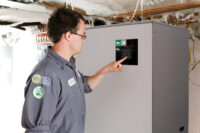
 Mechanical Hub continues its conversation regarding heat pumps and heat pump technology. Electrification and carbon reduction is core to the emergence of heat pump technology. We recently spoke with Mark Chaffee, VP Governmental Affairs and Commercial & Industrial Product Management, Taco Comfort Solutions.
Mechanical Hub continues its conversation regarding heat pumps and heat pump technology. Electrification and carbon reduction is core to the emergence of heat pump technology. We recently spoke with Mark Chaffee, VP Governmental Affairs and Commercial & Industrial Product Management, Taco Comfort Solutions.
MH: What are some of the driving forces behind heat pump technology?
Chaffee: The key, driving factor is a desire for CO2 reduction by using less fossil fuel. The world’s leading cultures and political forces have chosen to pursue beneficial electrification as a key component to achieve reduction goals. So, how is it that we can most quickly, substantively reduce our dependence on fossil fuels—a key contributor to carbon emissions? Heat pump technology is the HVAC industry’s best foot forward in achieving this today.
The effort to accomplish decarbonization is broken into two primary camps: a.) at the grid (source) level, and b.) equipment (local).
At the grid level, our 50 states are all at different places in implementing this. And, for the technology that’s involved residentially, and commercially, the ability of heat pumps to deliver COP’s (coefficient of performance) of 3, 4 and 5—meaning operational efficiencies of 300, 400 and 500 percent, or more— can’t be ignored. In comparison, fossil fuel burning equipment can achieve efficiencies of maybe 92 to 98 percent at best.
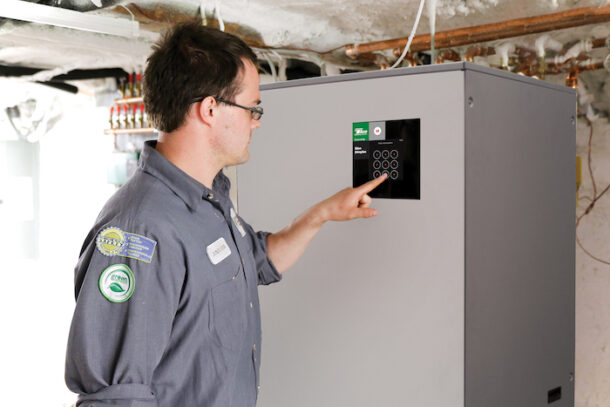
The goal: clean, efficient grid energy in combination with the highest efficiency HVAC solutions possible. Then install some solar panels on your house or commercial building (distributed green energy) for another win. Heat pumps measure up effectively as viable equipment solutions to keep people comfortable year-round.
MH: What are the benefits of heat pump technology?
Chaffee: At Taco Comfort Solutions, we believe that the best, no-compromise product offering comes from air-to-water systems; we want to be sure they have a seat at the table. They offer extreme energy efficiency, and the finest heating and cooling solutions with the greatest options and flexibility for delivery of that comfort—such as low-temperature radiant heat and towel warmers, etc. And: cooling, too. Hydronic technology is the undisputed king of comfort for humans.
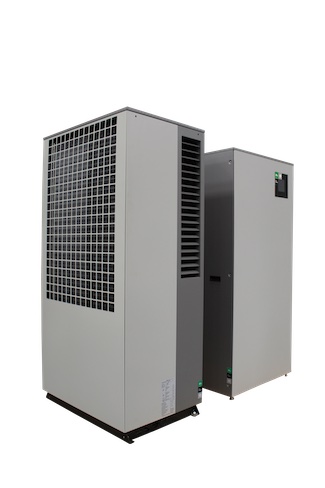 With so many other heat pump technologies (for instance, mini splits, VRF or split system HVAC equipment), refrigerants are the means of thermal exchange across all facets of the distribution network. Refrigerant lines may pierce roofs, and course their way through attics and walls from condensing units to air handlers or terminal units. We prefer the much improved means of using water as the primary source of distribution; it’s safer, less expensive and more efficient. We know water to be the cleanest and most efficient medium of thermal exchange. Simply, more BTUs can be transported by water than by refrigerant compounds or by forced air.
With so many other heat pump technologies (for instance, mini splits, VRF or split system HVAC equipment), refrigerants are the means of thermal exchange across all facets of the distribution network. Refrigerant lines may pierce roofs, and course their way through attics and walls from condensing units to air handlers or terminal units. We prefer the much improved means of using water as the primary source of distribution; it’s safer, less expensive and more efficient. We know water to be the cleanest and most efficient medium of thermal exchange. Simply, more BTUs can be transported by water than by refrigerant compounds or by forced air.
We aren’t comparing heat pumps with boilers here. For generating high temperature water, there’s nothing better than a sturdy boiler. On the other hand, we are comparing air-to-water heat pumps with forced air systems and traditional ground-sourced geothermal systems, the latter of which can also consistently provide efficient, decarbonized comfort, though with substantial up-front costs to accomplish geoexchange.
Air-to-water heat pumps are a viable solution and can deliver no-compromise, year-round comfort without wells, deep and grouted boreholes, trenches, or underwater heat exchangers.
Heat pumps offer extreme efficiency, with heating and colling for year-round comfort. Some of them, like ours, also provide super-efficient heating of domestic water—all from a single appliance-like device.
MH: Do you see demand for Heat pumps more on the residential side than commercial? What’s the ratio?
Chaffee: We’ve all seen the explosive growth of mini-splits in the US residential market. To a large extent, homeowners have accepted and appreciate them. In the commercial sector, VRF technology has also seen broad acceptance, but there’s a tougher battle for dominance of the market—including the hydronic technology that we at Taco have invested in heavily.
Air-to-water systems represent a small percentage of both markets—residential and commercial—though with great potential for growth. After all, their superior comfort and technology offerings is matched with the ability to decarbonize. They can also handle the domestic hot water loads as part of a singular system.
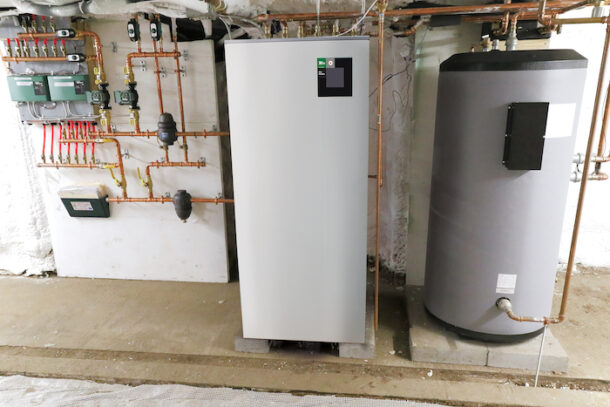
Consider, too, that a lot of refrigerant compounds have come and gone in the last couple of decades. As increased regulatory and environmental efforts removed more from the market, the long-term viability of distributed refrigerant-based systems comes into question. Why rip out and replace an existing system just because refrigerant laws change? Hydronics has always been able to adapt and upgrade to environmental, regulatory or technology changes.
I hope we see a great deal more demand for water-based systems in both the commercial and residential markets to help meet the demands for a low carbon society.
A ratio? Right now, the growth trend is affecting both markets equally, though overall—the residential market has seen faster growth initially.
MH: Can the grid support a HP transition?
Chaffee: Probably not, in its current state. But that won’t stop anyone from trying to achieve 100 percent clean energy. But, there’s a lot of work to be done to improve grid conditions before this can accomplished.
MH: Is a different skill set required for installation?
For the most part—no. Most trade professionals in the market today have everything they need—from expertise on tap, skills and tools—to accomplish proper installation of heat pumps. Those who already have a refrigerant license have a step up. Though, what little refrigerant there is within our System M is fully sealed at the factory in the outdoor unit, so no refrigerant license is needed to install the unit.
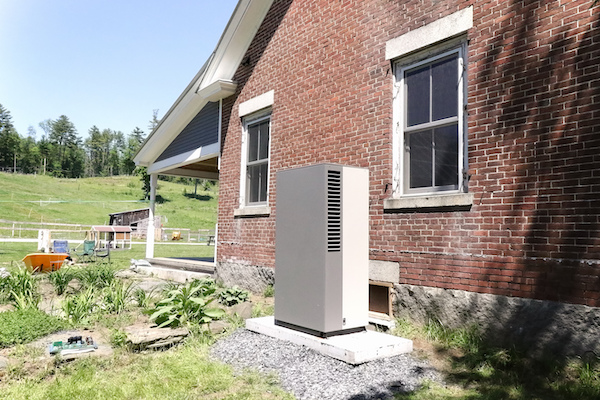
There are two types of heat pumps as defined by refrigerant technology:
- Monobloc—all refrigerant and the compressor are within the exterior unit, factory-sealed; refrigerant-to-water is the medium for thermal exchange. Only water moves to and from the exterior unit to the home or business for space conditioning.
- Split—these systems move refrigerant from the outside condensing unit to the inside of a structure in the process of air-to-refrigerant, or refrigerant-to-air thermal exchange.
MH: Life expectancy compared to boilers?
Chaffee: Nothing lasts like a boiler. Though many improvements have been made to boilers through the years, chiefly to enhance efficiency, their ability— by design—to heat water and transport it out for distribution, and then back again, is unsurpassed. In round numbers, a boiler’s lifespan is about 30 years.
Now, consider the rate new HVAC technology introductions over the past decade or so. In that same 30 years, a lot of new technology will emerge to supplant any appliance on the market today, and some will see the influence of refrigerant compounds that will be legislated-out, making them obsolete. It’s become broadly accepted that if an appliance lasts 15 to 20 years, its met its expectation.
Essentially, today’s air-to-water heat pump systems are appliances— considering their construction and durability. With proper installation and routine maintenance, they should last 15 to 20 years.
MH: Will you offer training for these products?
Chaffee: Yes. Taco provides training for all of the technology it offers to the market. We’re passionate about the support we offer to installers and system designers, the System M air-to-water heat pump will allow us to continue to educate on products and system design, especially as we look to implement high performance, energy efficient HVAC system.
MH: Other thoughts?
Chaffee: Glad you asked! We’ve heard this question on many occasions from a wide range of trade professionals: “Why does Taco want to offer this technology?”
The answer stems from our combination of expertise in hydronics, thermal distribution and comfort. These different facets meet and combine uniquely in our newest technology—the System M. It’s a single-source, air-to-water, turnkey heat pump system designed and built to meet the comfort and efficiency needs of a low-carbon society.
If we at Taco can help the trade to accomplish this, all the better. After all, that’s been an important part of our makeup dating back more than 100 years now. In the past decade or so, we’ve made a concerted effort to move from our role as a component manufacturer to that of a systems provider. With System M, we’ve combined no-compromise comfort with environmental benefits. And, considering that the technology is easy to size and install, it’s a win-win from many perspectives.

Like many others in the plumbing industry, Chase Wenger started out on the weekends helping his dad, who is co-owner (with Chase’s uncle) of C.V. Wenger Inc., Chambersburg, Pa. “When I was a kid, I hated cleaning the house so I would leap at any chance to go to work with my dad. We’d stop for Read more
Like many others in the plumbing industry, Chase Wenger started out on the weekends helping his dad, who is co-owner (with Chase’s uncle) of C.V. Wenger Inc., Chambersburg, Pa. “When I was a kid, I hated cleaning the house so I would leap at any chance to go to work with my dad. We’d stop for gas, and he’d buy me a soda and a candy bar, and we’d ride around to jobs and spend the day together,” says Wenger. “Those are some of my fondest memories,” recalls Wenger. “I put my first boiler in with my dad when I was in elementary school, and from that point on I was hooked.”
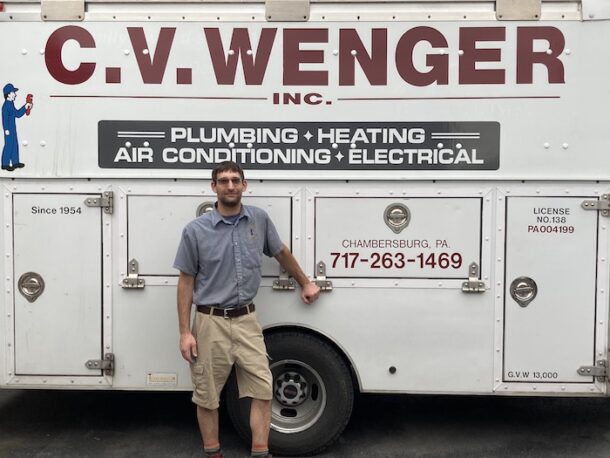
Chase owes a lot to his dad, uncle and grandfather—who started the company in 1954—who all become mentors in some fashion. “They taught me to do the best I can no matter what, to be resourceful, and to think outside the box, while always encouraging me to learn more,” says Wenger.
In addition, Dan Holohan is a huge mentor for Wenger as well, even if he doesn’t know it. “I recall telling him one time about a steam system I put in from scratch, he shook my hand and told me, ‘Congratulations, that automatically makes you 65 years older kid, great job.’”
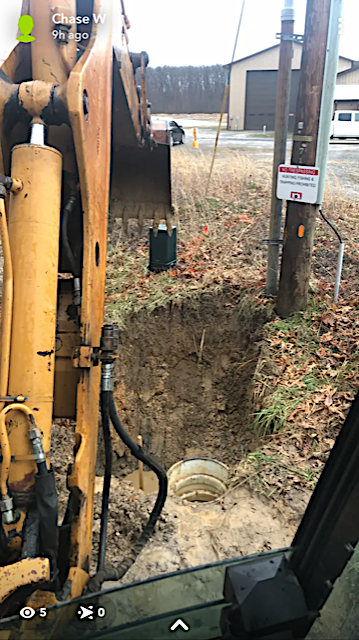 Wenger likes to think that that every tradesman he’s ever met/worked with was a mentor, continuously trying to learn something new from everyone he meets. Although he fondly recalls shakily holding the flashlight for his dad as a young boy’s mind wandered around almost as much as the flashlight beam, searching through the truck for the 5th time for that screwdriver he’s sure he left back there. “If you want to keep a kid indisposed for a bit, just assign them a mission they can’t complete if you have that one thing they’re searching for hidden in your toolbox. LOL,” says Wenger.
Wenger likes to think that that every tradesman he’s ever met/worked with was a mentor, continuously trying to learn something new from everyone he meets. Although he fondly recalls shakily holding the flashlight for his dad as a young boy’s mind wandered around almost as much as the flashlight beam, searching through the truck for the 5th time for that screwdriver he’s sure he left back there. “If you want to keep a kid indisposed for a bit, just assign them a mission they can’t complete if you have that one thing they’re searching for hidden in your toolbox. LOL,” says Wenger.
Moving on Up
Chase made his way to washing trucks and stocking shelves, eventually moving on to help with installs. Then one especially busy day, a lead guy didn’t come to work. “I was instantly upgraded to a full-fledged tech/plumber. As I learned more, I decided I needed to get my Masters Plumber License. From that point on, I started to design my own systems in addition to installing them,” says Wenger.
 And while Wenger’s official title of Supervisor/Lead Field Foreman has him lead larger projects—from commercial to residential—from both installation and service work, as well as troubleshooting and tech support roles for other technicians, one of the most rewarding things to me is helping out someone in need, whether it’s replacing a broken well pump, resolving his/her water quality problems or restoring a customer’s heat in the dead of winter. “Although, making a customer’s dirty, brown-stained, sulfur-smelling water into delicious crystal clear water is especially satisfying for me,” says Wenger.
And while Wenger’s official title of Supervisor/Lead Field Foreman has him lead larger projects—from commercial to residential—from both installation and service work, as well as troubleshooting and tech support roles for other technicians, one of the most rewarding things to me is helping out someone in need, whether it’s replacing a broken well pump, resolving his/her water quality problems or restoring a customer’s heat in the dead of winter. “Although, making a customer’s dirty, brown-stained, sulfur-smelling water into delicious crystal clear water is especially satisfying for me,” says Wenger.
Wenger also enjoys replacing old worn-out systems—wells, water systems, drainage systems, heating/air conditioner systems, etc.—with new efficient ones while cleaning them up and generally making them better all around.
 Wenger’s main specialty is well pumps, water treatment, excavation, in addition to regular service/install work with anything the company offers. Oh, and by the way, Wenger is also a licensed Master Electrician, HVAC tech, and he runs a sheet metal shop.
Wenger’s main specialty is well pumps, water treatment, excavation, in addition to regular service/install work with anything the company offers. Oh, and by the way, Wenger is also a licensed Master Electrician, HVAC tech, and he runs a sheet metal shop.
But with all hard work comes some play time, right? “It’s always a tricky balance, but you just need to set specific boundaries and make time to do the things you want to do.” For Wenger, kayaking, reading, spending time with my family and friends is time well spent. A bucket list item? “Definitely kayaking over more waterfalls, or trying wing-suiting in Scandinavia.
Moving the Industry Forward
Moving forward, the industry needs to continue to eliminate the stereotype of the plumber as an unclean, uneducated worker would be a good start, says Wenger. Also, “We need to showcase how rewarding/satisfying the profession/industry is, offering education/training. A lot of people dislike working on things that they don’t completely understand, and paying them what they’re worth,” says Wenger.
Social media has helped the trades’ image problem. “It’s definitely helped me meet others in the trade, well beyond my regular service area,” says Wenger. “I’ve learned a lot from seeing how others do things and talking with them. I like to think everyone can teach you something in life—even if it’s simply what not to do.”
In the end, it’s about passing the torch. “I tend to forget that I’m not the new guy anymore, even after 15 years. I certainly hope I can be a role model for others both in the trade, and those considering joining this marvelous trade, and any other trade out there. It’s a wonderful career to have,” says Wenger.
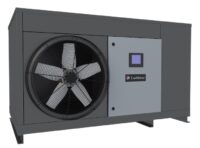
According to a recent study by Global Market Insights, the air source heat pump market value is projected to cross $77 billion by 2028. Increasing demand from growing real estate sector along with soaring requirement of space heating applications across colder regions will encourage the product deployment. Air to water source heat pumps segment is Read more
According to a recent study by Global Market Insights, the air source heat pump market value is projected to cross $77 billion by 2028. Increasing demand from growing real estate sector along with soaring requirement of space heating applications across colder regions will encourage the product deployment.
Air to water source heat pumps segment is anticipated to witness a noteworthy growth owing to various features including simple design and easy installation, says the report. Rising global temperature and growing green building construction will provide positive drivers for product deployment. Integration with solar heating source and hence low input cost for product across temperate countries will drive the space heating systems demand in the forecast timeline.
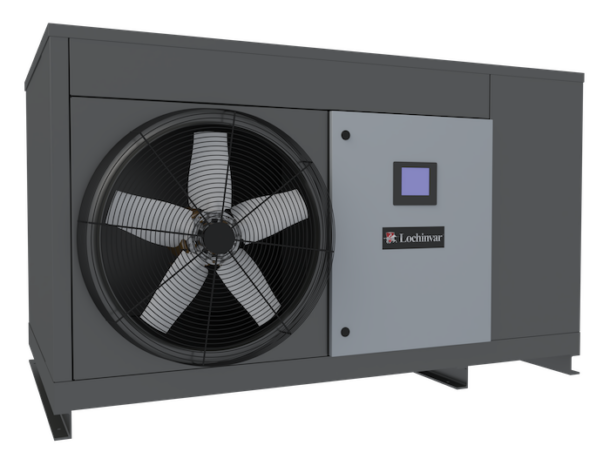
Lochinvar’s air source heat pump water heater
The movement towards electrification—moving away from fossil fuel—seems to be the main driver of the heat pump movement. “I think consumers see an option to add PV, or join a solar garden, to become more energy independent. So having a heating, cooling and DHW option powered by your roof makes some sense. The rise in fossil fuel prices, uncertainty around supply certainly adds some motivation to look at heat pumps,” says Bob ‘Hot Rod’ Rohr, training manager, Caleffi, and former hydronic contractor of more than 30 years.
Recently, Mechanical Hub spoke with Arthur Smith, Residential Product Manager, A. O. Smith, and Jennifer Russell, Segment Development Manager, Decarbonization, Lochinvar, to get the latest on heat pump technology and heat pumps water heaters.
MH: What are some of the driving forces behind this technology?
Arthur: At A. O. Smith, we’ve seen two major driving factors behind the increasing popularity of residential heat pump water heaters. First, as consumers have begun to see wider availability of this technology, along with its carbon emissions reduction and tremendous cost savings, they’ve pushed to utilize heat pump water heaters in their own homes, further increasing demand. The second driving factor we’ve seen is the evolving regulations around decarbonization. These changes have placed an emphasis on heat pump technology as an excellent option for greenhouse gas reduction.
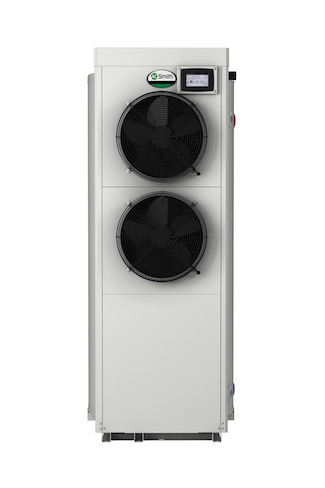
A. O. Smith’s CHP-120 heat pump water heater
Jennifer: On the commercial side, greenhouse gas emission reduction is the main driving force behind the increase and development of heat pump technology. However, due to the lack of availability of commercial heat pump technology, we don’t see it utilized in applications as often as the residential sector. In addition to state and local reduction goals, there are also many companies and building owners who are setting their own goals for reducing greenhouse gas emissions and they’re seeking out heat pump water heaters as a way to meet those goals.
MH: What are the benefits of heat pump technology?
Arthur: The core benefit of heat pump water heaters is the massive jump in efficiency. High efficiencies drive cost savings, which is a huge benefit to homeowners.
Jennifer: One of the main benefits of heat pump technology is that there are zero direct carbon emissions from the unit. For any commercial building looking to decrease its environmental impact footprint, this technology can play a big role in meeting those goals. In addition to the environmental benefits, heat pump technology is also incredibly efficient, providing an average annual efficiency of 200-300%.
MH: Do you see demand for heat pumps more on the residential side than commercial? What is the ratio?
Arthur: Overall, we’ve seen significant interest in both commercial and residential applications.
Jennifer: At Lochinvar, we’ve seen interest in both commercial and residential applications. Interest in ommercial applications for heat pump water heaters has grown significantly in the last couple of years, primarily due to evolving state and local environmental regulations.
Can the grid support a heat pump transition?
Arthur: The grid has been able to support the transition so far, but as heat pump technology continues to increase in popularity, developing the grid will need to be prioritized. It seems that most regulators are aware of this need to develop the grid and are building their regulations accordingly so the grid isn’t overwhelmed.
Jennifer: While the grid may be able to support a heat pump transition eventually, it can’t happen overnight. It’s going to take many years to fully develop a grid that can support a full transition to heat pump technology. In the meantime, we can develop and implement tools, such as demand-response technology, to help support the transition.
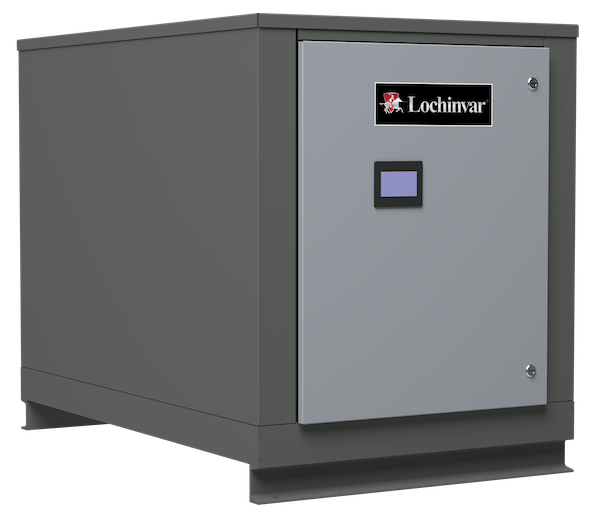
Commercial Heat Pump Water Heater
MH: Is a different skill set required for installation?
Arthur: On the residential side, there isn’t a different skill set required for installation. A. O. Smith designed our residential heat pumps so they can be installed in almost the same way as our standard electric water heaters. There are still some minor considerations, like draining non-acidic condensate produced by heat pumps and differing space requirements, but overall, the installation process is nearly the same as what most contractors are familiar with now.
Jennifer: There isn’t a different skill set required for installation, but there is unique training that can better prepare someone to install or service heat pumps. Heat pump water heaters have features that differ from traditional water heaters and these features require different training. Lochinvar offers training to help educate on the unique application features of heat pump technology.
MH: What is the life expectancy compared to boilers?
Arthur: Our heat pump water heaters are built to the same quality standards as all A. O. Smith products. We put care into developing products that perform well throughout their lifetime. We’re confident in our products and offer a standard 10-year limited warranty on every heat pump we produce.
Jennifer: You’re not going to see any loss of life expectancy with heat pump water heaters. They’re designed to hold up and perform as well as other water heating technology
MH: Do you offer training for these products?
Arthur: Since residential heat pump technology has been around for a bit longer than commercial, we’ve had time to develop training resources that focus on the installation and servicing of these units. A. O. Smith University offers digital live training at www.university.hotwater.com and there are courses available that focus specifically on heat pump technology.
Jennifer: At Lochinvar, we offer training resources to educate sales reps, engineers, contractors and technicians on heat pump technology. At the moment, our heat pump training focuses on topics such as applications for heat pumps, ensuring the correct unit size specification and understanding the technology’s benefits and features.

San Antonio — The seventh Emerging Water Technology Symposium returned as an in-person event for the first time in four years, bringing together industry, manufacturing, water utility and government leaders from around the world. A focus of this year’s event was on resources communities require to build safe and resilient plumbing systems as well as Read more
San Antonio — The seventh Emerging Water Technology Symposium returned as an in-person event for the first time in four years, bringing together industry, manufacturing, water utility and government leaders from around the world. A focus of this year’s event was on resources communities require to build safe and resilient plumbing systems as well as meet the growing list of challenges to America’s drinking water.
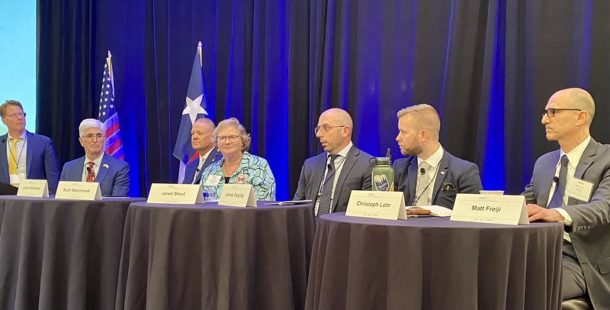
The esteemed panel on Effective Risk Management of Building Water Systems for Pathogen Control included (from l to r) Julius Ballanco, president, JB Engineering; Kurt Steenhoek, International Representative, UA; Janet Stout, Executive VP and Founder, Special Pathogen Laboratory; James Dipping, Director of Plumbing Engineering, Environmental Systems Design, Inc.; Christoph Lohr, VP of Strategic Initiatives, IAPMO; and Matt Freije, CEO, HC Info.
The May 10-11 event at the Westin Riverwalk, San Antonio was co-convened by the Alliance for Water Efficiency (AWE), the American Society of Plumbing Engineers (ASPE), the International Association of Plumbing and Mechanical Officials (IAPMO) and Plumbing Manufacturers International (PMI).
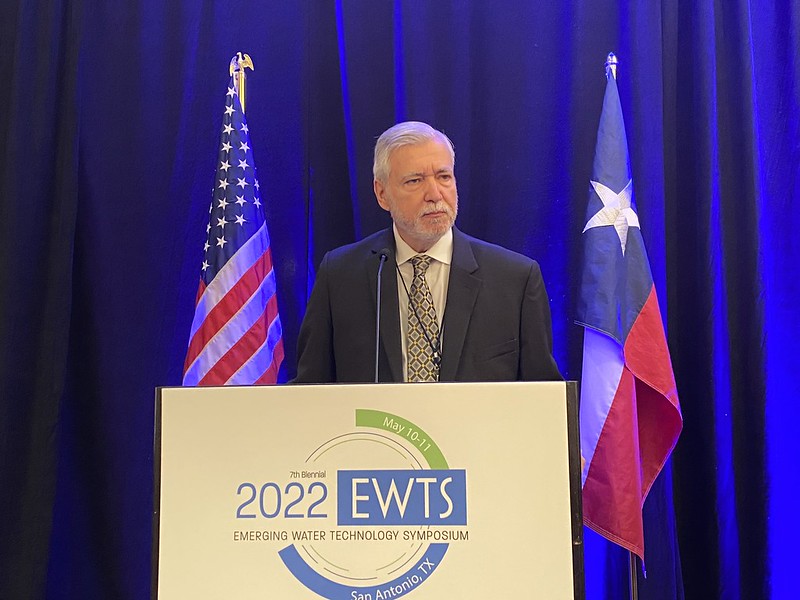
Pete DeMarco
“As an industry we have a number of high priority research needs that relate to water quality as well as water and energy efficiency,” IAPMO Executive Vice President of Advocacy and Research Pete DeMarco explained in discussing the importance of the symposium. “This year’s event brought together some of the brightest minds industry has to offer all focused on how we make our plumbing and mechanical systems safer and more resilient to meet the challenges ahead.”
In his opening remarks, DeMarco pointed to a number of accomplishments for which the EWTS has served as a springboard, including the development of the Green Plumbing and Mechanical Code Supplement (now the Water Efficiency and Sanitation Standard WE•Stand); ANSI/ASHRAE Standard 188-2018, Legionellosis: Risk Management for Building Water Systems; ASSE 12000 series on infection control and water quality, which is in IAPMO’s Uniform Plumbing Code (UPC®); and IAPMO’s Water Demand Calculator, whose second version was released in 2020.
“This symposium provides a much-needed platform for stakeholders across the industry to gather, discuss the latest research, and then discuss how we can take action,” he said. “It is a highly valuable event, and I look forward to seeing it continue to grow in the future.”
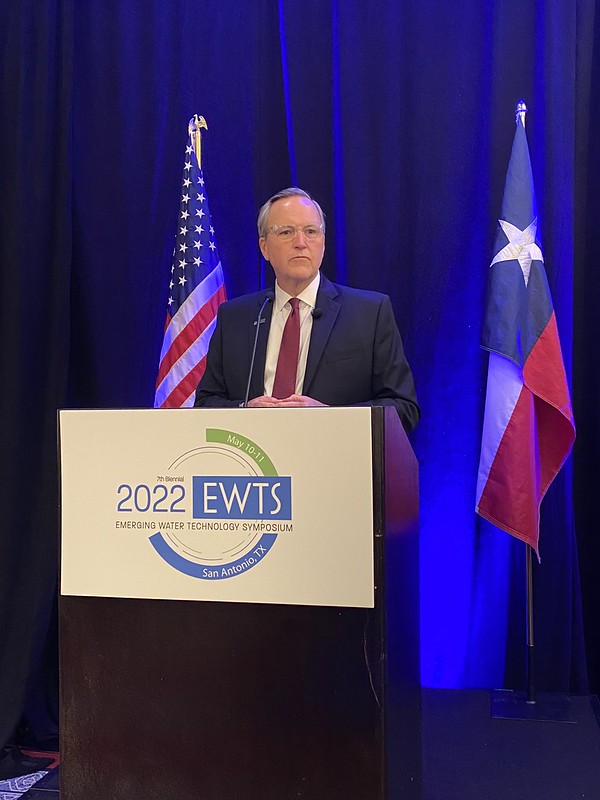
Kerry Stackpole
PMI CEO Kerry Stackpole spoke at the event and said the relationships between the organizations represented at EWTS had likely never been more important than they are now. He said that while the best and brightest among us devised medical solutions to the COVID-19 pandemic, the plumbing industry also played an important role.
“What’s also important is how our industry responded,” he said. “Our industry’s experience and our focus became touchless faucets, antimicrobial surfaces, water purification systems, all kinds of energy-efficient devices focused on safe and responsible plumbing. We all had a contribution to make and I think our industry stepped up.”
Stackpole said wildfires, flooding and drought that different regions of the United States are experiencing put those in the industry in a position to shape the future.
“Your active engagement here, in your communities back home, and in the marketplace of ideas, where we will have opportunities to share ideas with one another, will make all the difference,” he said. “You actually are able to turn the dial on this, and I think that’s really exciting.”
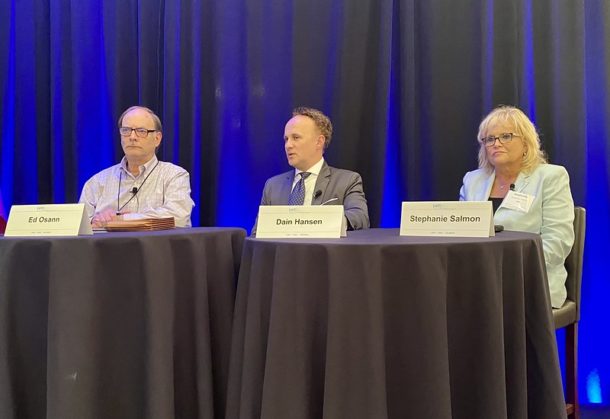
A day 2 panel saw (from l to r) Ed Osann, Senior Water Policy Analyst, NRDC; Dain Hansen, Executive Vice President, Government Relations, IAPMO; and Stephanie Salmon, Washington Representative, PMI, talk about the implications of the Infrastructure Investment and Jobs Act on Drinking Water and Wastewater.
This year’s keynote speakers were Robert Puente, president and CEO of the San Antonio Water System (SAWS), and Don Johnston, senior operations director, Indonesia, for Water.org.
Puente’s presentation looked at three ways in which SAWS, which serves 2 million customers over four counties, uses innovation to deliver water to its customers: advanced metering deployment, “smart” manhole covers, and conservation.
“It’s all about innovation,” he said. “And I think if you talk to our employees, although they will tell you that it’s their idea, we know that they got their idea from coming to events like this. Every good idea, you should expect it to be stolen, to be used by someone else, and you should be flattered by that. I think anything that you look at here started somewhere else, and we went to conferences in other cities and were able to bring back the ideas to SAWS to really get the innovation aspect in this.”
In delivering his keynote address remotely from Jakarta, Indonesia, Johnston spoke about the global water and sanitation crisis’s impact on low-income households — one in nine people lack access to safe water, one in three do not have access to a toilet — and some potential solutions. Working with financial institutions and water utilities, as well as sister company WaterEquity, Water.org helps bring affordable financing to people in need of water.
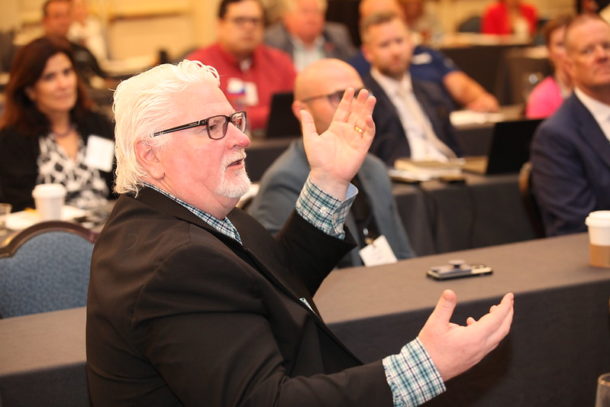
The Hub’s John Mesenbrink asks the hard-hitting questions during the symposium.
“In about 19 years of work on the ground, we’ve seen water and sanitation access reach more than 45 million people through more 10 million microloans disbursed to households with capital of $3.7 billion mobilized,” he said.
In his presentation, Phillip White, manager of plumbing and mechanical inspections for the city of Vancouver, British Columbia, shared how his city addressed the problem of insufficient sewer capacity when it came to capturing large amounts of rainfall through water reuse technologies. One development, the Oakridge Centre, utilized the IAPMO Water Demand Calculator and is expected to have the largest non-potable water system in North America.
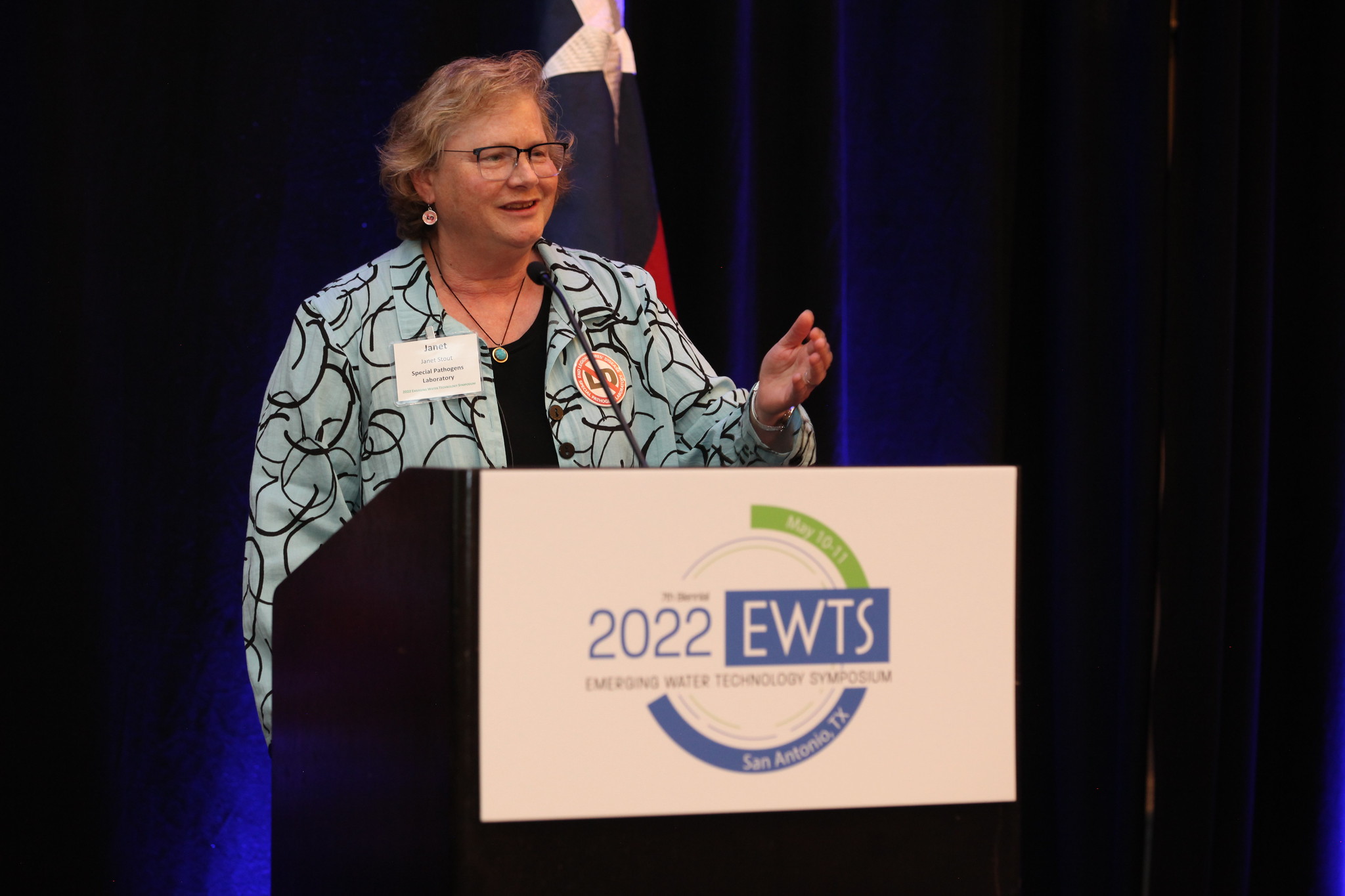
Janet Stout
Another speaker, Special Pathogens Laboratory Executive Vice President/Founder Dr. Janet Stout, looked at approaches and products for mitigating the risk of Legionellosis in point-of-use and point-of-entry building water systems. Improved water management requires knowledgeable Legionella prevention and water service providers, which can come from certification to ASSE/IAPMO/ANSI 12080 for Legionella Water Safety and Management Personnel.
IAPMO will provide sessions from the EWTS on-demand in the near future. To be notified when they are available, register at www.ewts.org/2022-ewts.

Flagship showroom in Fulton Market District highlights Sloan’s full suite of aesthetic, hygienic commercial restroom products. Chicago—On a dreary Tuesday morning in early May, Sloan sparkled by holding a ribbon-cutting ceremony to celebrate the opening of its flagship showroom and office space in the Fulton Market District. The flagship showroom highlights Sloan’s full suite of aesthetic Read more

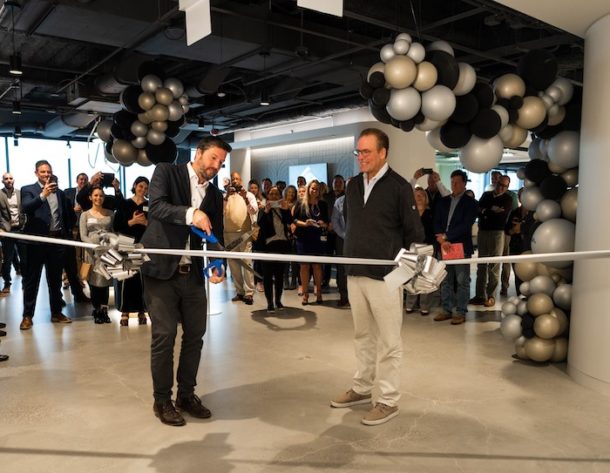
Taking part in the ribbon cutting ceremony for the new space were Graham Allen and Kirk Allen, Sloan co-presidents and CEOs and fourth generation descendants of company founder William Elvis Sloan.

The Hub’s John Mesenbrink took part in some AR technology from the showroom.
Located on the building’s 10th floor, Sloan’s showroom space represents a return to the company’s origins, as Sloan was initially founded on nearby Jackson Boulevard prior to moving to its current Franklin Park headquarters in 1975. The new building features an office space and showroom, while Sloan’s manufacturing and corporate headquarters remains in Franklin Park.
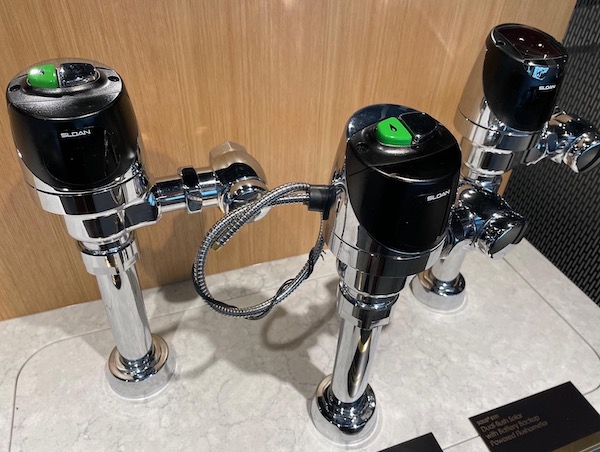
The showroom features a wide range of Sloan products and innovations, including flushometers.
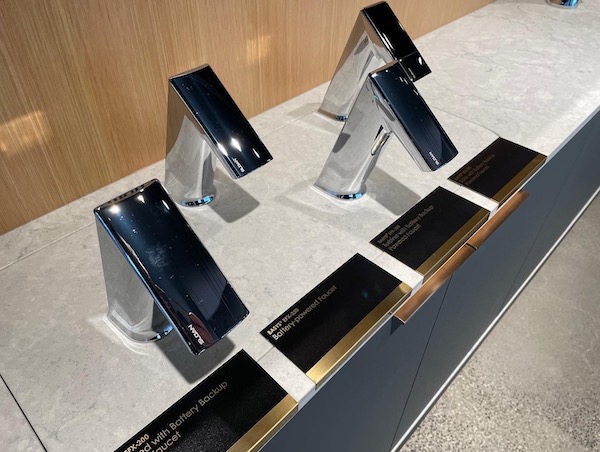
The showroom features a wide range of Sloan products and innovations, including sensor-activated faucets.
